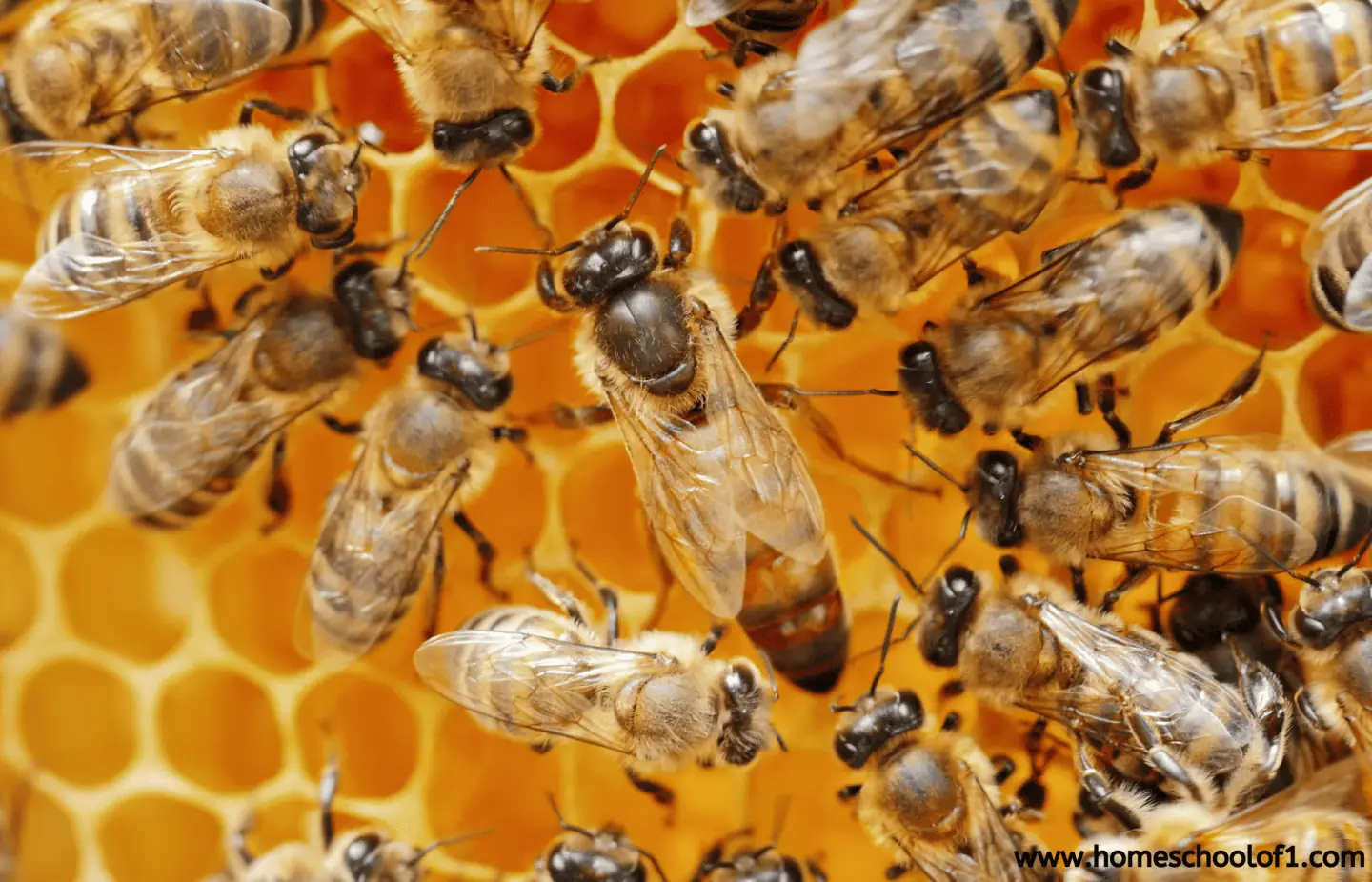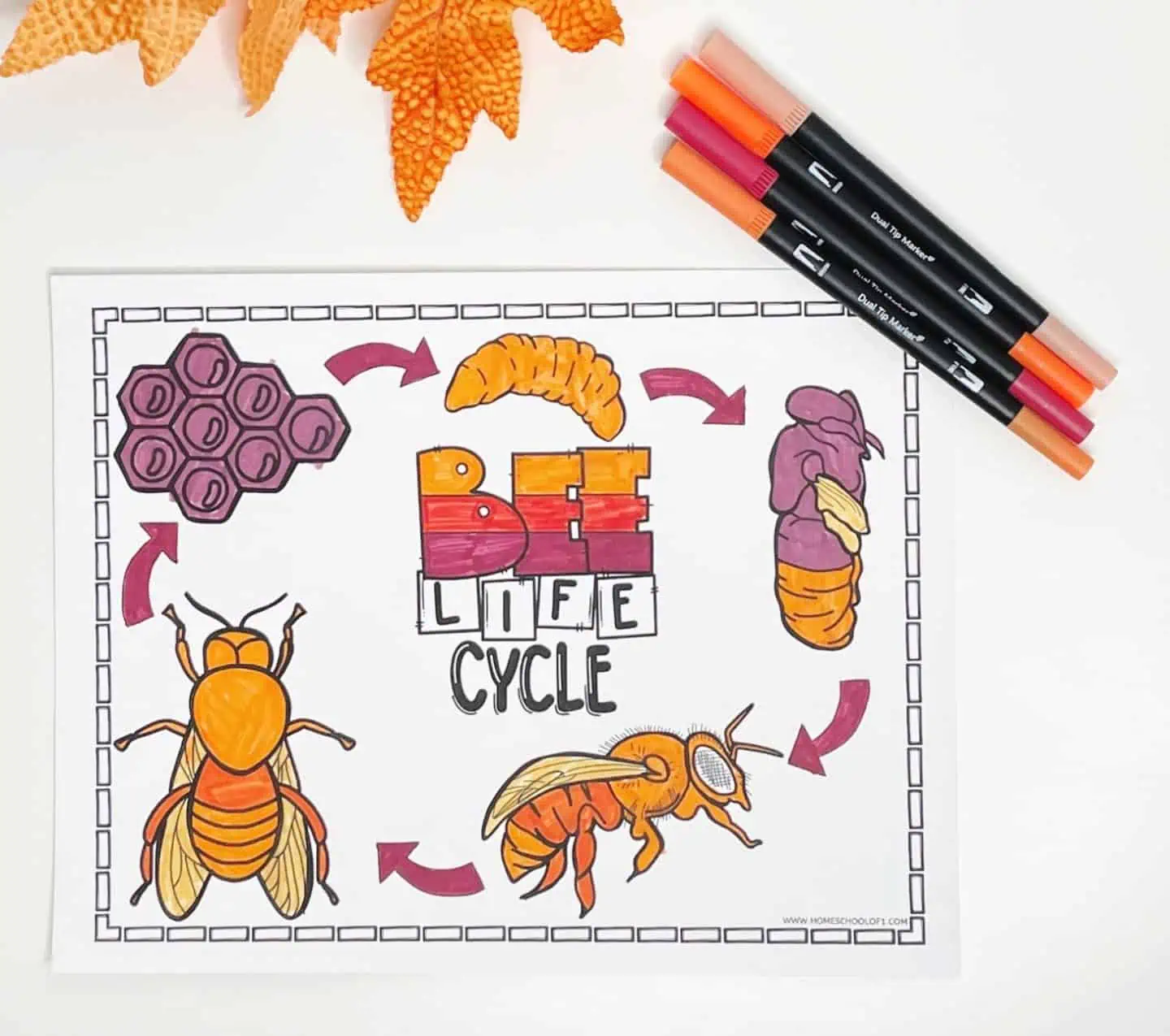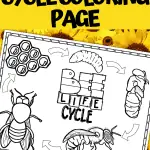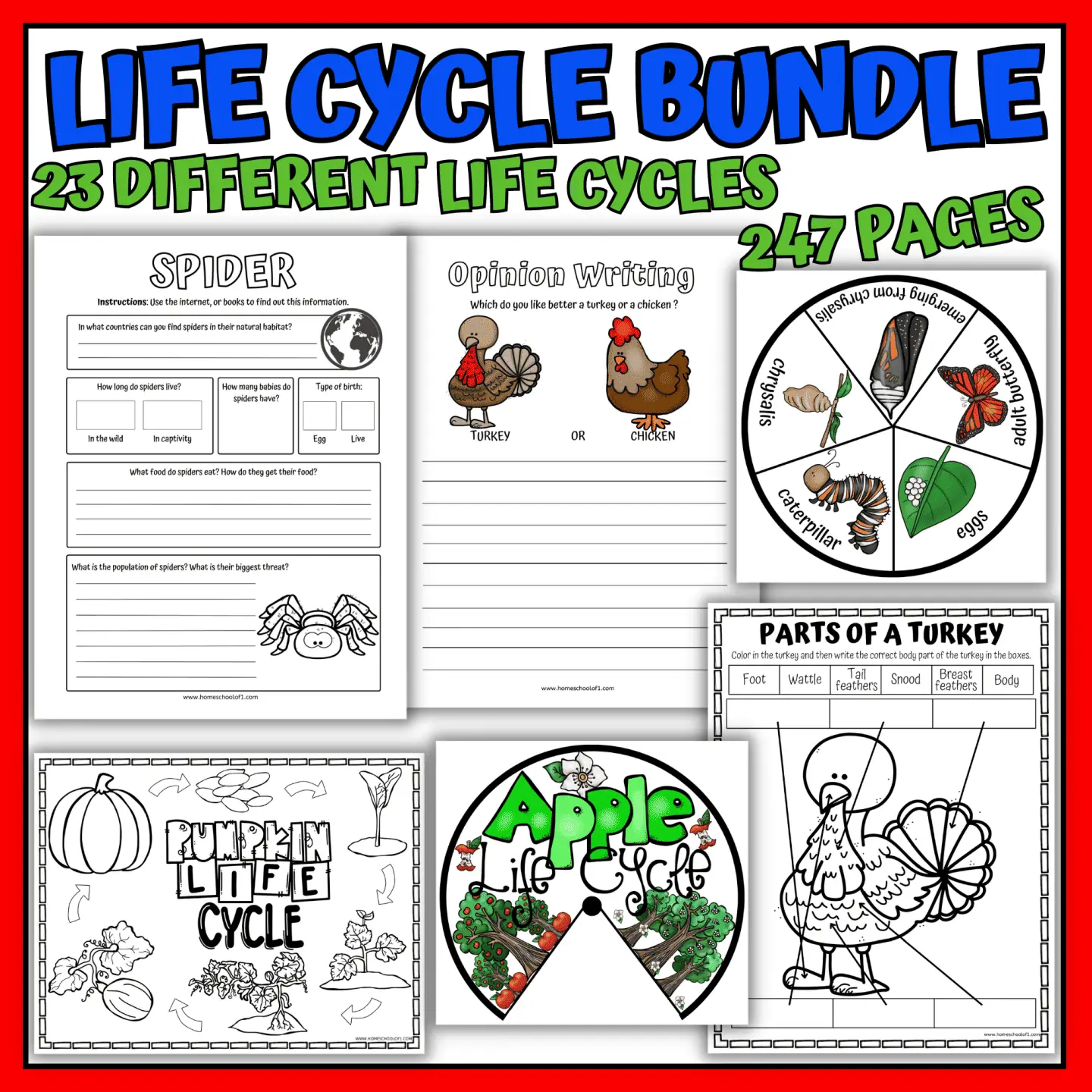Free Bee Life Cycle Coloring Page
Kids will love learning about bees with this bee life cycle coloring page!
As they color each stage, from egg to adult, they’ll gain a deeper understanding of how these incredible insects grow and their essential role in pollination.
This hands-on free life cycle worksheet is perfect for nature studies, science lessons, or a fun creative break.

**This post may contain affiliate links. As an Amazon Associate and a participant in other affiliate programs, I earn a commission on qualifying purchases.**
Stages of the Bee Life Cycle (Color Along!)
Bees go through an amazing transformation, and you can follow along while coloring each stage on your bee life cycle coloring page!
Here’s how bees grow from tiny eggs into buzzing workers, pollinating flowers along the way.
Egg stage – The queen bee lays tiny eggs inside honeycomb cells. Each egg is about the size of a grain of sand. Kids can color this stage white or light yellow to show the tiny eggs.
Larva stage – After a few days, the eggs hatch into small, worm-like larvae. They don’t have wings or legs yet. Worker bees feed them royal jelly and bee bread to help them grow. White or pale cream works well for the larvae, with golden honey around them.
Pupa stage – Once fully grown, the larvae spin silky cocoons around themselves. Inside, they go through metamorphosis, just like a butterfly. This stage can be colored light brown or tan to represent the cocoon.
Emerging adult – After about a week, the new bee chews its way out of the cocoon and unfolds its wings. Black and yellow can bring this stage to life.
Adult bee – Now fully grown, bees take on different jobs. Some collect nectar, others care for the young, and some guard the hive. Kids can use bright yellow and black stripes to color their adult bee.

Why Bees Matter
Bees are essential pollinators, helping flowers, fruits, and vegetables grow by spreading pollen.
One bee can visit over 5,000 flowers in a single day. Without them, many foods like apples, almonds, and blueberries wouldn’t exist.
As kids color their bee life cycle worksheet, they can think about how bees help our world. What would happen if there were no bees?
Want to explore more about insect life cycles? The Life Cycles book is a great companion to this coloring page, with detailed illustrations and easy-to-understand explanations of how bees and other creatures grow.
How to Use the Life Cycle of a Bee Coloring Sheet
This coloring page makes learning about bees interactive and fun. Here are some ways to use it for different learning activities:
- Label the Stages – Have students write the name of each stage (egg, larva, pupa, adult) on the worksheet to reinforce vocabulary.
- Color Coding – Assign different colors to each stage to help children visualize the transformation process.
- Storytelling Activity – Ask students to imagine they are a bee going through each stage. What do they see? How do they feel? Encourage them to tell or write a short story based on their journey.
- Pair with a Read-Aloud – Read a book about bees while kids color to enhance comprehension and engagement.

By adding these simple activities, the coloring page becomes more than just an art project—it becomes an interactive learning tool.
Educational Benefits
Using this free coloring page helps children develop key skills while having fun:
- Fine Motor Skills – Holding crayons and coloring within the lines strengthens hand-eye coordination and grip control.
- Cognitive Development – Understanding the sequence of the bee life cycle improves logical thinking and science comprehension.
- Language Skills – Discussing the life cycle introduces new vocabulary and encourages communication.
- Creativity & Storytelling – Coloring and imagining the journey of a bee nurtures creativity and critical thinking.

Looking for more activities? Our bee-themed preschool printables include fun crafts, simple worksheets, and hands-on learning ideas for younger learners.
More Bee-Themed Learning Activities
Want even more bee-themed fun? These activities go beyond coloring and help kids explore bees in creative and hands-on ways.
- Free printable bee life cycle worksheets: Explore each stage of a bee’s life with engaging activities.
- Label the parts of a bee worksheet: Learn about bee anatomy with this interactive labeling activity.
- B is for bee handprint: A fun letter recognition craft perfect for preschoolers.
- Bee name craft: A personalized activity from Simple Everyday Mom to inspire creativity.
- Bee sensory bin: A hands-on activity from Fun-A-Day that encourages exploration.
- Free bumble bee counting cards: Early math skills meet fun with this printable set from Stay at Home Educator.
Best Books About Bees for Kids
Reading about bees brings their world to life beyond the coloring page. These are a few books we’ve loved in our home—engaging, beautifully illustrated, and packed with fascinating bee facts.
- The Honeybee by Kirsten Hall – This book has been a favorite in our house. The rhythmic storytelling and bright illustrations make it a joy to read aloud. It’s a simple yet beautiful way to show how bees work together.
- Give Bees a Chance by Bethany Barton – If your child isn’t a huge fan of bees yet, this book might change that! It’s funny, packed with cool facts, and does a great job explaining why bees are so important.
- The Bee Book by Charlotte Milner – We love this one for its mix of fun illustrations and real science. It’s a great choice for kids who want to dig deeper into the world of bees beyond just the life cycle.
These books make great companions to the bee life cycle coloring page, helping kids connect even more with these incredible pollinators.
Need to print later? Add this to your Pinterest board or share it on Facebook. You’ll have it handy whenever you’re ready to use it!
Get the Free Bee Coloring Page Here!
Want even more life cycle activities? Get our Life Cycle Worksheet Bundle with 247 pages covering 23 different life cycles—perfect for hands-on learning all year!
Ready to grab your free printable? Just pop your name and email into the form below, and it’s all yours!
Last Updated on 6 March 2025 by Clare Brown





